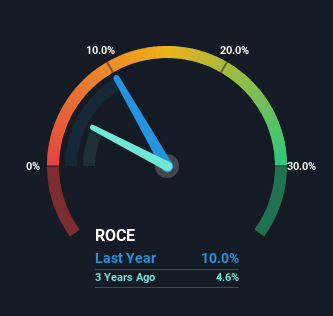Telstra Group (ASX:TLS) Is Looking To Continue Growing Its Returns On Capital

What trends should we look for it we want to identify stocks that can multiply in value over the long term? Firstly, we'd want to identify a growing return on capital employed (ROCE) and then alongside that, an ever-increasing base of capital employed. If you see this, it typically means it's a company with a great business model and plenty of profitable reinvestment opportunities. So when we looked at Telstra Group (ASX:TLS) and its trend of ROCE, we really liked what we saw.
Return On Capital Employed (ROCE): What Is It?
Just to clarify if you're unsure, ROCE is a metric for evaluating how much pre-tax income (in percentage terms) a company earns on the capital invested in its business. The formula for this calculation on Telstra Group is:
Return on Capital Employed = Earnings Before Interest and Tax (EBIT) ÷ (Total Assets - Current Liabilities)
0.10 = AU$3.6b ÷ (AU$46b - AU$10.0b) (Based on the trailing twelve months to December 2023).
Therefore, Telstra Group has an ROCE of 10%. In absolute terms, that's a satisfactory return, but compared to the Telecom industry average of 7.3% it's much better.
See our latest analysis for Telstra Group

In the above chart we have measured Telstra Group's prior ROCE against its prior performance, but the future is arguably more important. If you'd like, you can check out the forecasts from the analysts covering Telstra Group for free.
The Trend Of ROCE
Telstra Group's ROCE growth is quite impressive. The figures show that over the last five years, ROCE has grown 25% whilst employing roughly the same amount of capital. Basically the business is generating higher returns from the same amount of capital and that is proof that there are improvements in the company's efficiencies. The company is doing well in that sense, and it's worth investigating what the management team has planned for long term growth prospects.
What We Can Learn From Telstra Group's ROCE
To bring it all together, Telstra Group has done well to increase the returns it's generating from its capital employed. Investors may not be impressed by the favorable underlying trends yet because over the last five years the stock has only returned 35% to shareholders. So with that in mind, we think the stock deserves further research.
On a separate note, we've found 2 warning signs for Telstra Group you'll probably want to know about.
While Telstra Group isn't earning the highest return, check out this free list of companies that are earning high returns on equity with solid balance sheets.
Valuation is complex, but we're here to simplify it.
Discover if Telstra Group might be undervalued or overvalued with our detailed analysis, featuring fair value estimates, potential risks, dividends, insider trades, and its financial condition.
Access Free AnalysisHave feedback on this article? Concerned about the content? Get in touch with us directly. Alternatively, email editorial-team (at) simplywallst.com.
This article by Simply Wall St is general in nature. We provide commentary based on historical data and analyst forecasts only using an unbiased methodology and our articles are not intended to be financial advice. It does not constitute a recommendation to buy or sell any stock, and does not take account of your objectives, or your financial situation. We aim to bring you long-term focused analysis driven by fundamental data. Note that our analysis may not factor in the latest price-sensitive company announcements or qualitative material. Simply Wall St has no position in any stocks mentioned.
About ASX:TLS
Telstra Group
Engages in the provision of telecommunications and information services to businesses, government, and individuals in Australia and internationally.
Mediocre balance sheet low.
Similar Companies
Market Insights
Community Narratives



